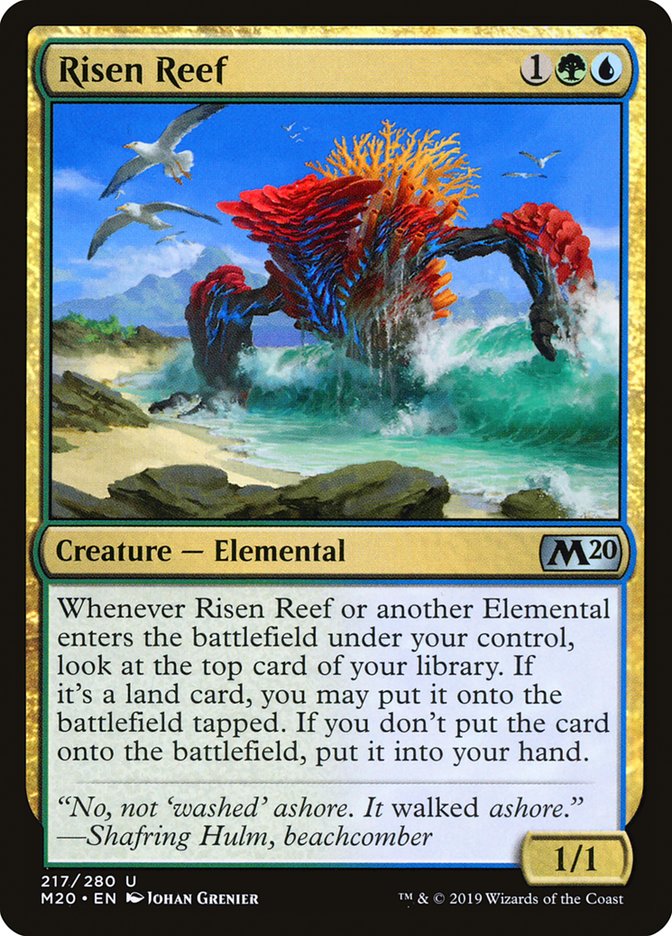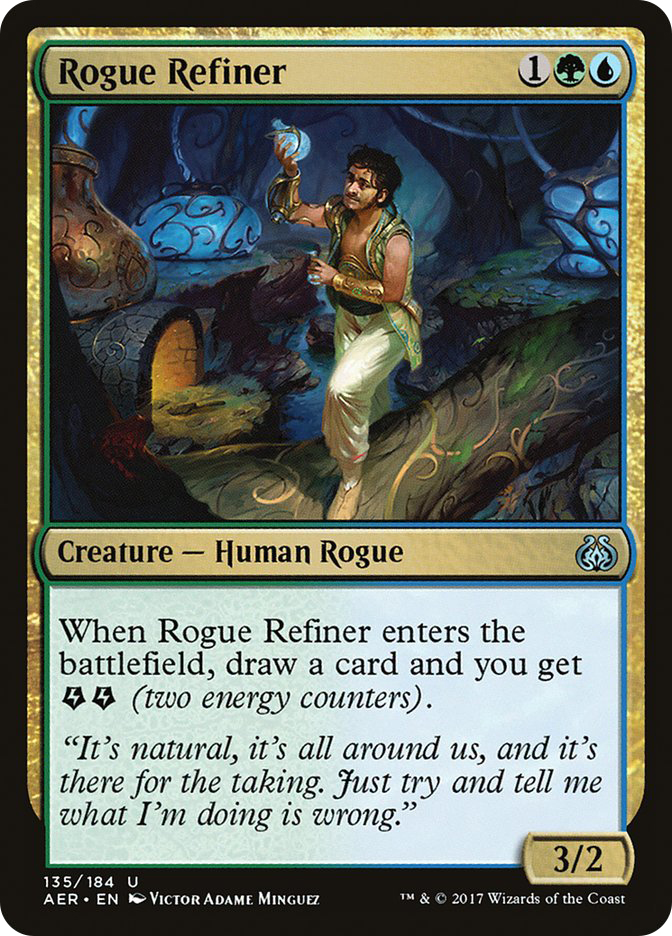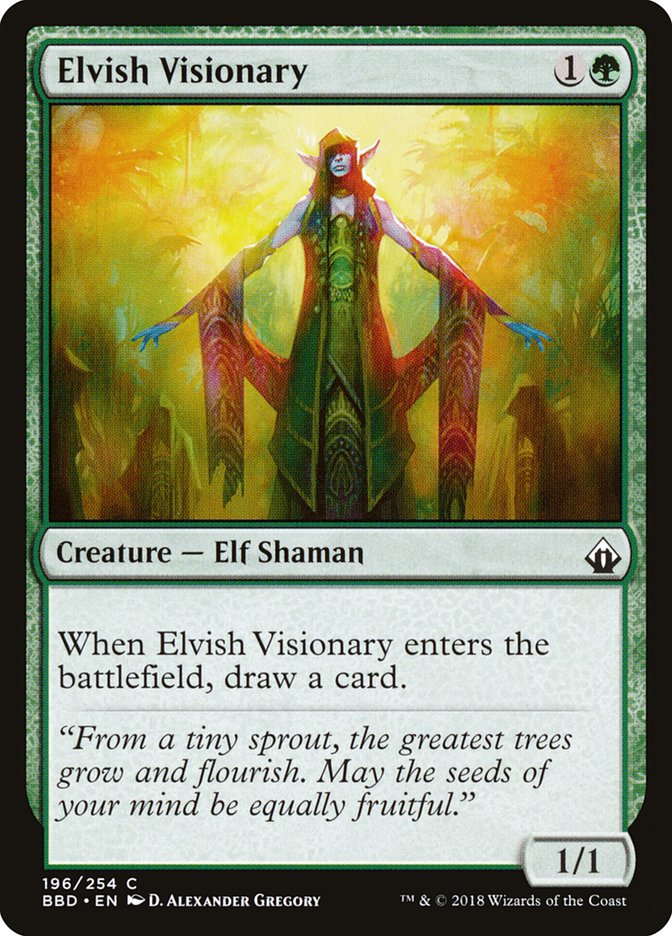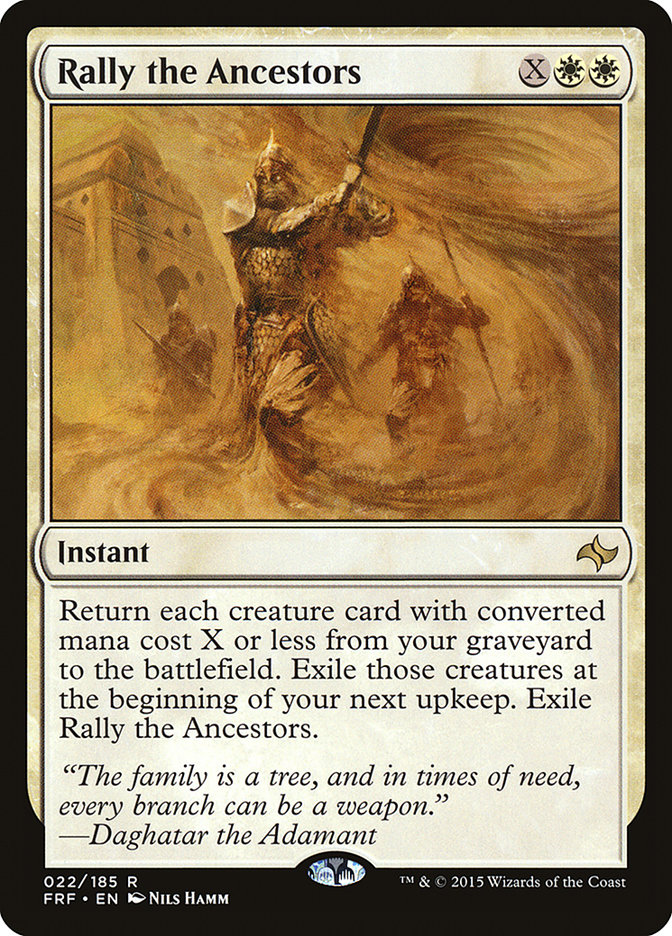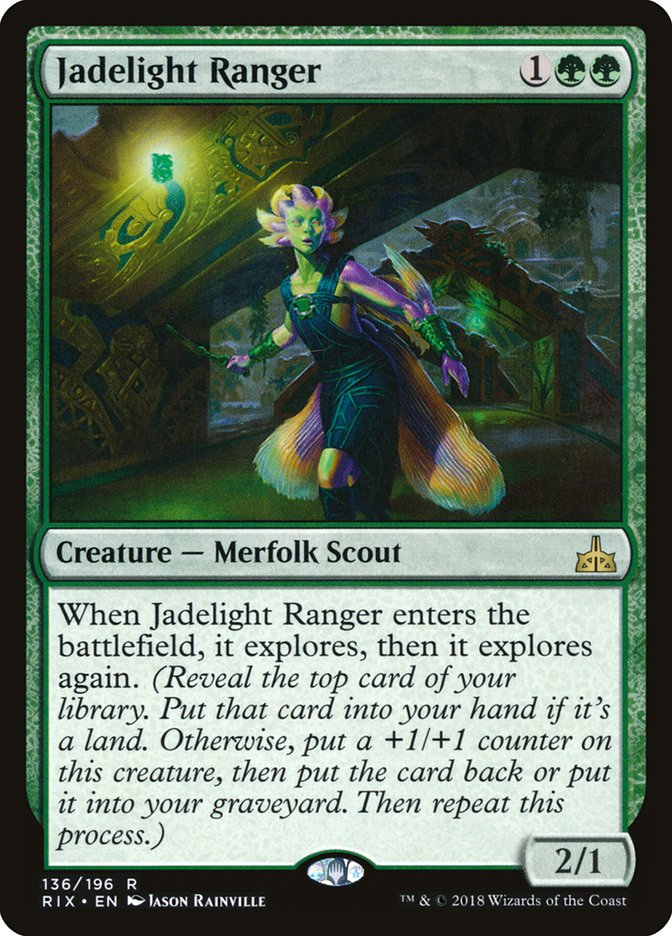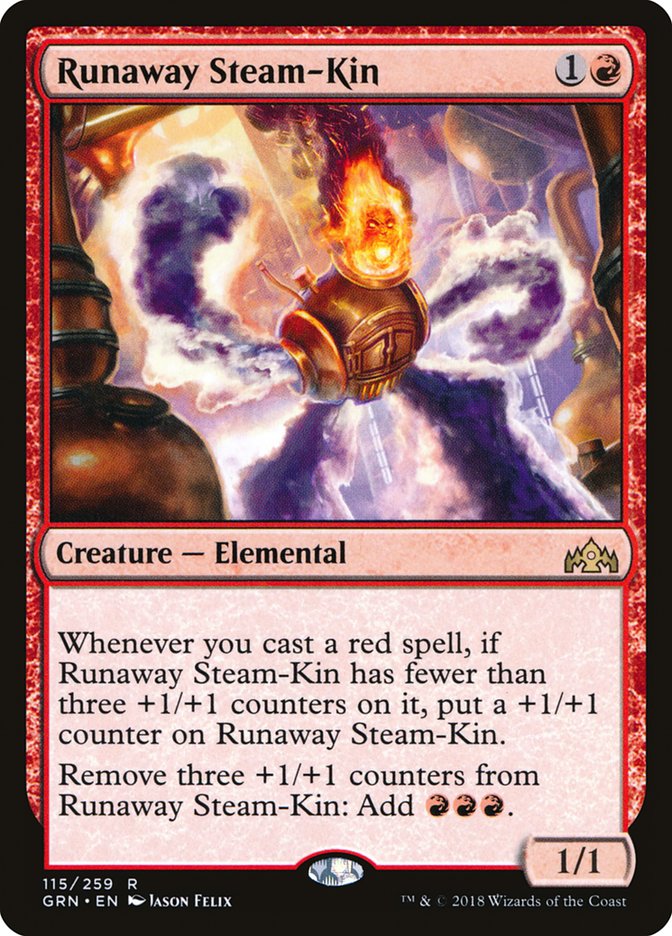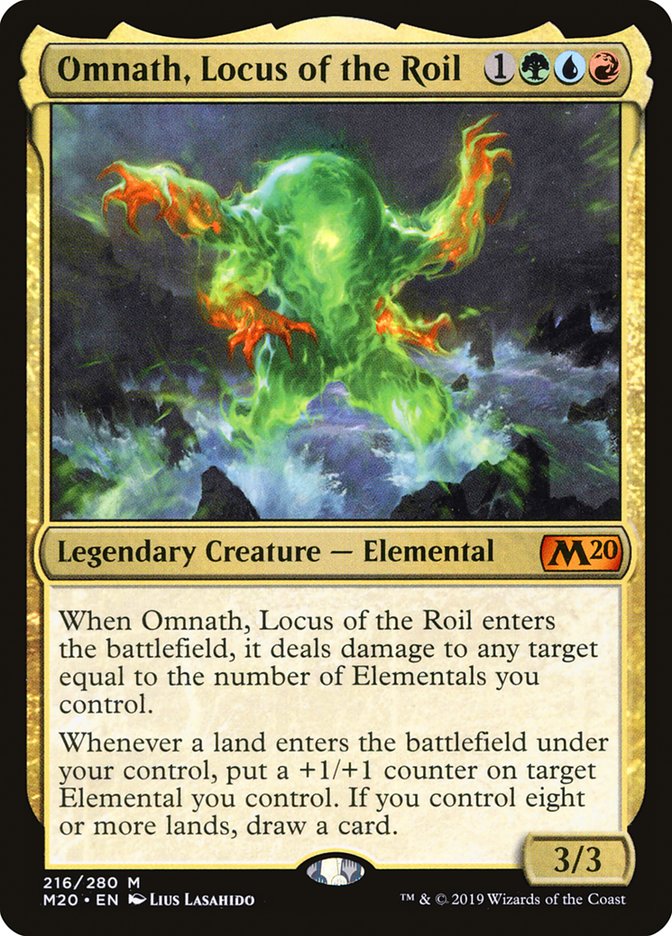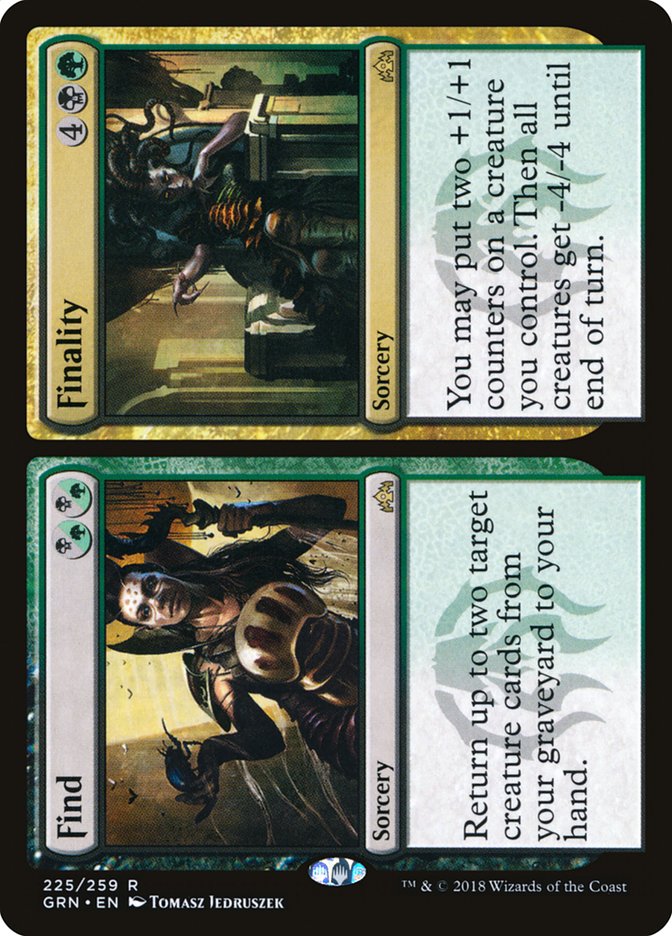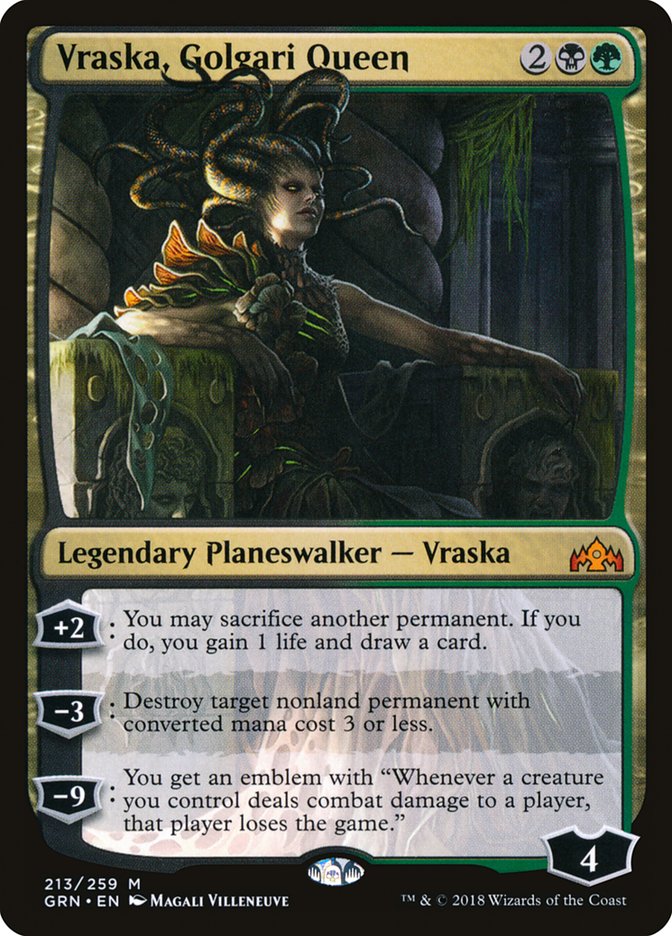So we’re really just gonna do this again?
It’s not like the last time this card was legal, it warped the format around it…
Okay, so it might not be exactly the same card, but you get the idea. A three-drop creature that replaces itself as an enters-the-battlefield ability in Simic colors should be paid a good deal of attention. The reason? The way that such cards impact decks that want a higher quantity of raw resources. When evaluating cards like Risen Reef and Rogue Refiner, think of them as different takes on Elvish Visionary.
Elvish Visionary was fairly unassuming when it was first printed but has since become one of the most important cards in the Legacy Elves deck and has seen play every single time it was in Standard. This is primarily because having a body attached to a card that can act as a synergy piece while also digging for more synergy pieces will have a lasting impact on a game.
During the reign of Four-Color Rally in Standard, Elvish Visionary didn’t do anything that utilized it in a way that was as on-the-nose as a tribal Elves deck. Four-Color Rally simply wanted a body and some payoff cards for having several creatures. Having a card that made it easier to continue hitting land drops, while also digging for the payoff cards of the synergy deck was fantastic. Against some of the lower-to-the-ground aggro decks, Elvish Visionary even had the added benefit of trading for smaller creatures.
Back to Rogue Refiner, it having a slightly bigger body made it so it was able to function in fairer decks, not just the combo-centric Aetherworks Marvel decks that it was initially slotted into. Sound familiar?
Jadelight Ranger can perform the same sort of role that Rogue Refiner did against slower controlling decks – reasonable pressure and a bit of card advantage for your trouble. The biggest downside that Jadelight Ranger has is that, while it sometimes had a bigger body than Rogue Refiner, that size meant that it wasn’t drawing a card.
Risen Reef doesn’t have that problem. What it lacks in size, it makes up for with the fact that it has the ability to generate so much more than a single card. People have already started trying to mess with ways to abuse the fact that Risen Reef triggers from every Elemental that enters the battlefield. I’ve had a bit of early success with this combo deck:
Creatures (32)
- 4 Runaway Steam-Kin
- 4 Living Twister
- 4 Creeping Trailblazer
- 4 Chandra's Embercat
- 4 Risen Reef
- 4 Omnath, Locus of the Roil
- 4 Scampering Scorcher
- 4 Scorch Spitter
Planeswalkers (4)
Lands (24)

Note that other than Risen Reef, every single spell in the deck is red. If you thought Runaway Steam-Kin with an Experimental Frenzy was bananas, wait until you see how Risen Reef and Runaway Steam-Kin work together.
Ultimately, the goal of the deck is to end up with copies of Runaway Steam-Kin and Risen Reef on the battlefield, and then start using the two together in order to begin chaining spells. Once a second copy of Runaway Steam-Kin gets added to the mix, it’s pretty easy to just keep casting spells until there’s a pocket of several consecutive lands.
Omnath, Locus of the Roil even gets to serve double duty as a payoff card and a minor combo piece. Every time a land gets flipped off Risen Reef, that’s another +1/+1 counter being put on an Elemental. It’s pretty useful when your mana engine relies on having +1/+1 counters in order to generate mana.
At a certain point, there are enough lands on the battlefield for Omnath to begin drawing cards with each land that enters the battlefield. The earliest I’ve had the deck win was on the fifth turn, but it hasn’t exactly been an uncommon occurrence. Does this look like a reasonable fifth turn?
The upside of the deck against some of the more controlling strategies of the format is that all the cards are ultimately proactive on their own. Sure, Chandra’s Embercat is mopey by itself, but most of the cards in the deck are going to get some sort of value, either in the form of cards or damage.
How can Risen Reef be used in deck that isn’t jumping through as many hoops to abuse it?
Creatures (16)
Planeswalkers (8)
Lands (25)
Spells (11)

The Standard Simic Ramp decks have waffled between using Nexus of Fate and Mass Manipulation as a payoff, but ultimately, the goal of these decks is to present a handful of threats that all put the opponent in a squeeze that makes them feel priced into answering every permanent that hits the battlefield.
The biggest thing that sets Risen Reef apart from its predecessors is that the opponent must answer it, lest it be worth even more later on. A Rogue Refiner coming down on the third turn could frequently be ignored for a time before being dealt with at the opponent’s convenience. If Risen Reef is ignored and its controller casts another one the following turn, the amount of value that each one generates starts to get out of hand. This is pronounced in the decks that are built around Elementals, but in a deck that’s chock-full of otherwise good value cards, it’s harder for a player to commit to answering Risen Reef.
When there are also mana creatures and planeswalkers, it’s hard to feel that Risen Reef is the best use of one’s removal. In this instance, the goal is to stretch the opponent’s removal so thin that there aren’t enough answers on their side for all the deck’s must-answer cards.
On the other side of the spectrum is the no-specific-card-matters approach:
Creatures (26)
- 4 Llanowar Elves
- 4 Wildgrowth Walker
- 4 Merfolk Branchwalker
- 4 Jadelight Ranger
- 2 Ravenous Chupacabra
- 4 Hydroid Krasis
- 4 Risen Reef
Planeswalkers (4)
Lands (24)
Spells (6)

The Sultai Midrange decks from pre-War of the Spark Standard all had a pretty basic interest: Stay alive and win on the back of the fact that every one of its cards would be worth two of the opponent’s.
Sure, Risen Reef is more likely to end up dying than Merfolk Branchwalker or Jadelight Ranger, but that’s still playing into Sultai’s gameplan. As long as their removal spell isn’t somehow making up for the fact that their card traded one-for-one, while your creature replaced itself, Sultai isn’t bothered by its creatures dying.
.rotate {
-webkit-transform: rotate(90deg);
-moz-transform: rotate(90deg);
-o-transform: rotate(90deg);
-ms-transform: rotate(90deg);
transform: rotate(90deg);
}
Find makes it easier to have creatures trade for removal, because, while it technically only rebuys two cards from its caster’s graveyard, if both of those cards are each worth more than a card, things snowball pretty quickly. In the same vein, Vivien finding a card that’s guaranteed to draw even more cards is just gravy. This deck even has the benefit of having another Elemental for a bit of creature-type synergy in Wildgrowth Walker.
It isn’t an accident that the Sultai Command the Dreadhorde decks have been loading up on tiny Vraska: with a host of three-mana planeswalkers running around, there are plenty of targets for her -3 ability. Risen Reef provides fantastic fodder for her +2, building an effective Divination when there isn’t any more value to be gained from Elementals in hand. On top of that, Risen Reef is more likely to create a situation in which its controller has a glut of lands, which also happens to be perfect for what Vraska is trying to convert to fresh cards in hand.
All That Value
Risen Reef isn’t designed for traditional aggro decks. Being a creature that replaces itself doesn’t matter as much as the fact that it’s three mana worth of investment into something that’s only providing a 1/1 body to the battlefield.
The aforementioned decks are the overarching play styles that Risen Reef will find itself in: Elemental Tribal, threat-dense big mana decks, and decks interested in getting as many two-for-ones as possible. The common denominator between these three decks? They’re all resource-heavy strategies.
With many cards during preview season, there’s always a question of whether they’ll be good enough for Standard play. Whenever building a midrange deck or grindy deck that plays to the battlefield, consider if Risen Reef is a card that you’re in the market for. It works as a roadblock, a draw engine, or something that can simply smooth out draws, with the occasional upside of ramping.
Rather than considering if something as versatile and generically good as Risen Reef will be able to cut it in Standard, I’d recommend skipping to the part at which the goal is to figure out what the best shell for Risen Reef is. It isn’t a matter of if. It’s a matter of when.


